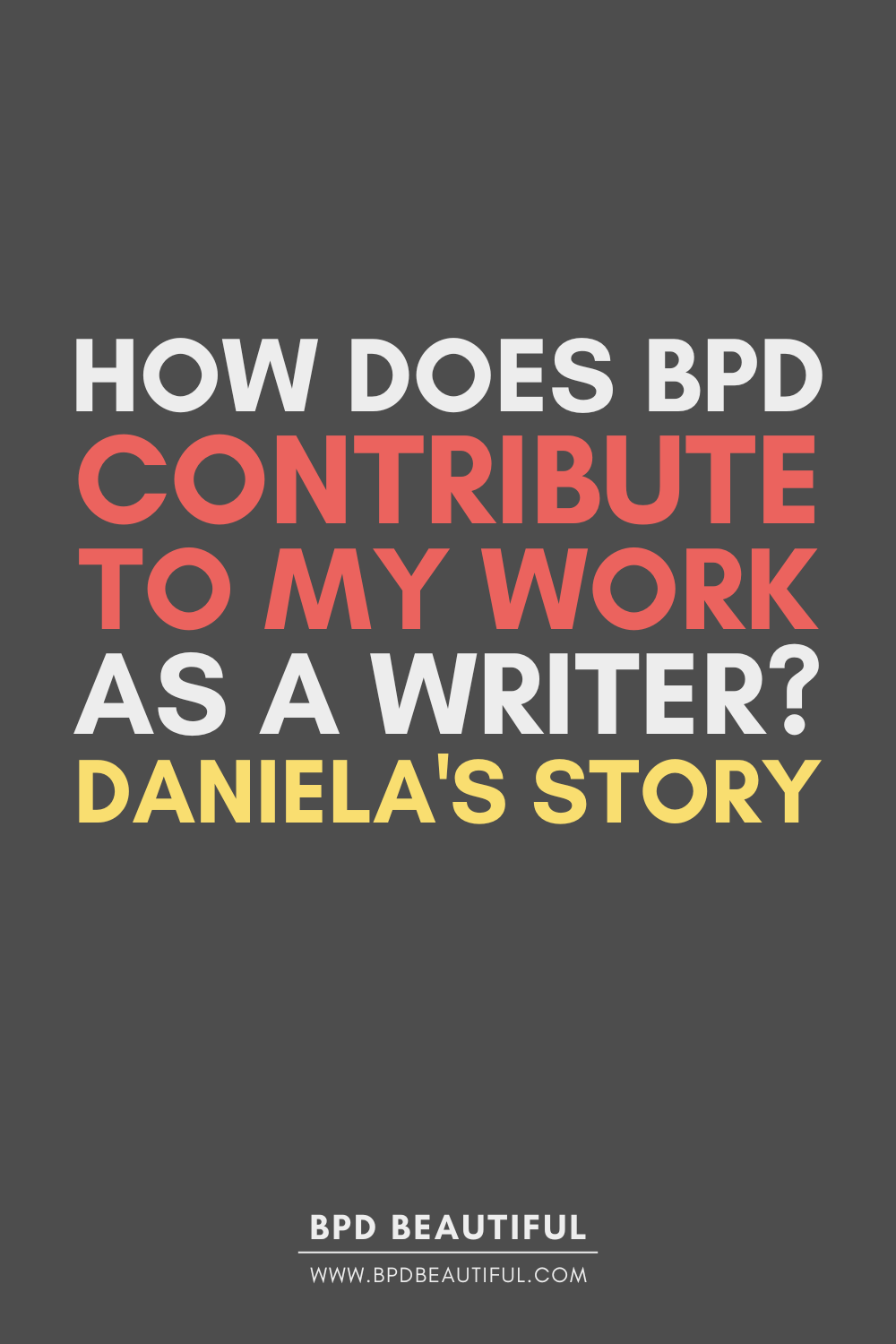The following post was originally posted on Psychreg
Writers with BPD
“For people with Borderline Personality Disorder, expressing themselves artistically can be an outlet for dealing with emotional instability, managing emotions, learning to see the world in a palette of colors (rather than in black and white), finding creative solutions to problems, and thinking outside the box. In this personal essay, I would like to shed light on how positive characteristics of the borderline trait such as intensity and passion, creativity, high sensitivity, and reactivity have been the driving force behind my career as a writer and help me to write profound and visceral articles for an audience that does not stop growing: a mental health audience!
After a series of misdiagnoses, as Borderline Personality Disorder can also have comorbidities such as depression and anxiety, I was diagnosed with BPD at the age of 38. Under the guidance of my psychiatrist, I got to know Dialectical Behavioral Therapy, a psychotherapeutic approach indicated for people with high emotional dysregulation.
Practice Gratitude with BPD Journaling
Because I already work as a writer, my therapist and I worked with a tool called “Gratitude Diary”. From a DBT perspective, gratitude can help us think more dialectically about our lives. Even on bad days, our ability to find something small to be thankful for reminds us that life is not ALL bad.
According to my psychologist, it would be a way of reflecting on positive aspects that occurred throughout the day and, at the same time, thanking them as opportunities for growth and development. In addition, the Diary of Gratitude would help me organize thoughts and feelings that are often confused or full of emotional overload while working on aspects of my writing in my articles on emotional health. Here are some tips of this tool and how aspects of my disorder have helped me to further enrich my work as a writer:
Be as specific as possible and open to details.
The gratitude journal is, first and foremost, an activity that uses the heart. This is something a person with BPD has plenty of since we act with passion and intensity. It is this passion that feeds our vision and perception of the subtleties of the environment, such as paying attention to the emotions of others and noticing subliminal dynamics in what is happening around us.
I always start my gratitude journal by reflecting on at least three things I’m grateful for, thinking of their good points with awareness and self-care. It strengthens my self-esteem and develops my self-confidence and resilience.
At work, when choosing an agenda for my articles, I use all my empathy, examining in detail how my writing can be useful for a certain topic related to human pain. To do this, I always start my articles by answering a question related to the theme, such as, “What does it mean to be a quiet Borderline?”
This heightened empathy, typical of the borderline trait, makes me reflect on each word I write and how my texts reach the human heart. It’s like placing the person at the center of the universe, as people with borderline personalities often place themselves.

As a BetterHelp affiliate, we receive compensation from BetterHelp if you purchase products or services through the links provided.
Think deeply about what you are grateful for.
When we are grateful for something, we reflect deeply on why we are thankful. Thus, it is necessary to think in depth about the positive lessons we draw from what happened to us that day. The intensity and passion of individuals with BPD make it possible to value the little things and small achievements of the day, reflecting deeply on each lesson.
That passion and enthusiasm are what give my work depth. I have a passion for the human mind and an enthusiasm for helping people deal with their pain, anxieties, and conflicts. So I do deep research on each expert and paper that I use as a source in my articles, always focusing on the person who will read it when it’s ready. I think deeply about the impact my article is having on the reader’s life and how my words can transform pain into love and suffering into relief.
Be personal and connect with people instead of things.
In the Gratitude Journal, I was able to exercise my patience and compassion by listing the positive aspects of my relationship with my father and sister, and this lessened my conflicts with both, thus restoring our parental ties. This is because, as we write, we learn to put our frustrations on paper rather than projecting them onto people and taking our anger out on them. This way, when we put ideas on paper, we rethink what went wrong at the same time that we think of ways to improve our relationships with people, with family, and with ourselves.
People with BPD are highly sensitive and may have an increased ability to detect facial expressions and subtle mood swings compared to people without BPD. Therefore, they can feel more connected to people in a deeper and more empathetic way, often assuming the identity of the person with whom they relate and wanting to resemble them, both in appearance and in their way of being.
In my work, the connection with people is fundamental for me to be able to develop articles that are increasingly assertive and aligned with the real mental health problems that people face. In practice, I do detailed research on the audience I write for. For instance, if it is an article about depression, I establish contact with testimonials from people with the disorder; to create greater empathy with individuals who, like me, are borderline, I am part of communities about the BPD.
Appreciate your resilience after each crisis.
A person with BPD can be both sensitive and resilient. It’s about the ability to deal with stressful events, and then rebuild your life. Resilience is not resistance. It is not suffering, without showing the pain you feel, but the ability to return to the pre-stress situation and yet learn from it. It’s taking a precious element out of pain and learning to embrace life despite the complexity it presents.
So, in the gratitude journal, I was instructed to write about the negative results that I avoided in life, such as the presence of crises, self-mutilation, episodes of intense anger, and how I am in the present moment. Observing and describing every little breakthrough in relationships and daily challenges.
Recommended Book: “Building a Life Worth Living” by Marsha M. Linehan – Buy at Amazon
This resilience is also built through exchanges and contact with other people who also have the disorder and through my writing as an author of articles on mental health. I understand how each person feels, lives, and deals with their disorder and how they can react positively to a problem or adversity, seeking a balance between reason and emotion.
Under this bias, the more I write, the more I realize that I am not alone, as my work expands contact and knowledge with people with BPD, chronic illnesses, and mental disorders. In addition, writing is therapeutic; it develops self-awareness and expands the possibilities of seeing life in a different light every day (because no day is the same as the other).
Be Creative and Register the Unexpected.
Unexpected moments in life, such as surprises and situations outside our routine, tend to trigger strong emotions in us. It is at this moment that our sensory channels must be more open, registering in our minds, hearts, and diaries what we feel, how we feel, and what fantastic lessons we learn from what surprises us the most. It could be a person, a place, an achievement, or a new situation at work. It doesn’t matter. You are the one who will set the tone and shine, because the feeling is yours alone. And experience is not exchanged; it is lived. Just let creativity speak louder, especially when emotions are in evidence.
Many people with BPD express their pain artistically, whether in music, film, painting, dance, or literature. Creative outlets can serve as a constructive means of emotional expression and self-discovery. It is a way of overflowing emotions, felt so deeply, in the form of verses, poems, diaries, musical lyrics, or, in my case, through the work I do with articles on mental health.
People with BPD often have an authentic and genuine nature. They are not afraid to express their emotions openly, and their vulnerability and willingness to be genuine can foster trust and intimacy with those around them. Expressing emotions through art, in addition to being a source of inspiration, is a journey of self-discovery.
Being creative and writing about mental health means capturing human pain and giving voice and meaning to soul anguish. It’s looking for creative adjustments for the problems of those who seem like the pain will never end. But there is always a way when we realize that we are not alone in our personal struggles, mainly when we share about them in our writing.
The relationship between BPD and creativity may have to do with its high reactivity and emotional intensity. People with BPD often navigate extreme emotional states, oscillating between intense happiness, anger, sadness, and despair. These intense emotions can serve as potent sources of inspiration and fuel the creative process. One of the healthiest ways I’ve found to express anxiety and pain is through writing. Gratitude (BPD) journaling, as well as my work as a mental health writer, have been strong allies in managing my symptoms while helping others recognize their triggers and shed light on healthy ways to understand their fears and manage their emotions.

Powerful Sensitive Writing Skills on BPD for Writers with BPD
The gratitude journal tool has increased my level of awareness about how I deal with my emotions and how I can learn to relate better with others. These attitudinal aspects have had a very positive impact on the way I communicate in different contexts in life, respecting my sensitivity and using it as a productive workforce in my texts on mental health.
Being sensitive in your writing allows you to connect with your audience, convey your message clearly, and avoid causing unintentional harm or offense. Sensitive writing tools may have to do with Borderline trait characteristics, such as:
- Ability to put yourself in the reader’s shoes, understand their emotions and needs, and address their concerns and interests.
- Write using a language that is sensitive, accessible, and easy to understand for your readers in order to ensure that the message is conveyed in a thoughtful way, with the heart.
- Give attentive feedback to your readers, always in a kind, respectful manner, and above all, seek to understand the other person’s point of view regarding comments on your article. Sensitive writing takes into account both the writer’s intent and the impact it can have on the reader.
As we can see, the characteristic sensitivity of the borderline personality, along with its passion, intensity, and creativity, promote empathetic, assertive, and respectful writing, crucial for effective communication in today’s diverse world. Features that I have improved both in my sensitive work with the Gratitude Journal and through my daily activity as a writer on mental health.

Looking for Characters with BPD?
Sign up below to read the first 6 chapters of Sadie’s Favorite – an upcoming novel by Sarah Rose, creator of BPD Beautiful.
BPD Resources
BPD Characters: Read the first 6 chapters of Sadie’s Favorite – an upcoming novel by Sarah Rose, creator of BPD Beautiful.
Get 20% off your first month of BetterHelp. Get matched with a licensed therapist within 48 hours. Subscriptions as low as $65/week, billed every 4 weeks. Cancel anytime.
Manage your BPD symptoms with a printable workbook.
See our recommended list of books about BPD.
Pin This Post
Are you a writer with BPD? Share your own living with bpd story in the comments. Please help support BPD Beautiful and spread BPD awareness by pinning it on Pinterest.


